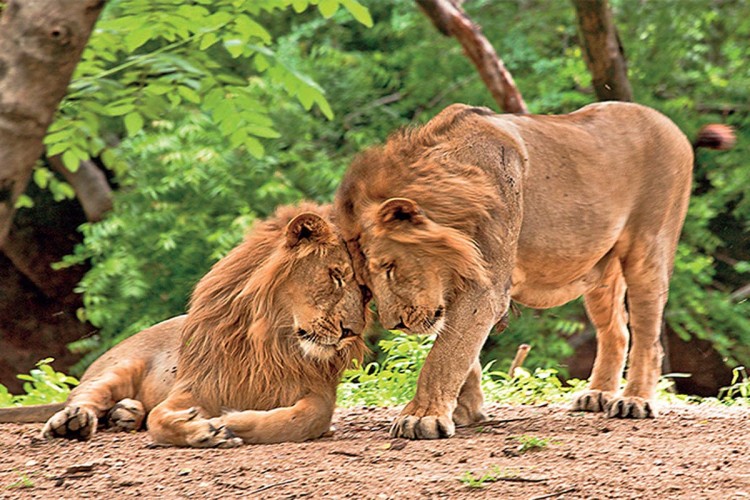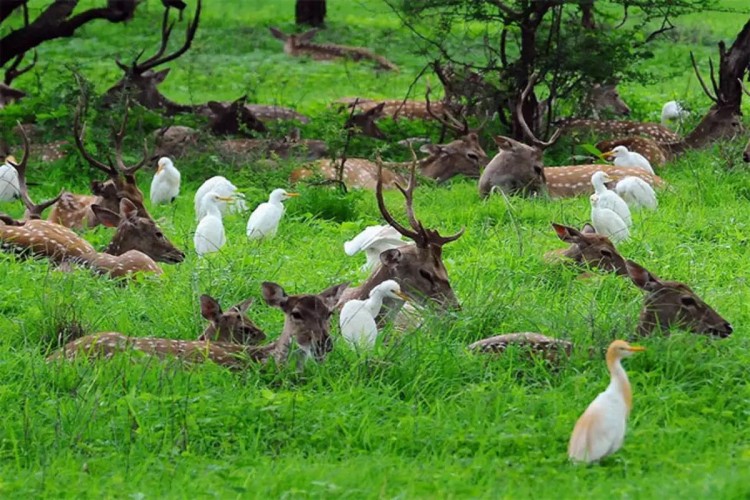About City
Gir National Park
"The land of Asiatic Lions"
Gir National Park and Wildlife Sanctuary is the only remaining home for the Asiatic Lions. Located in Talala Gir in Gujarat, the Sanctuary is a part of Kathiawar- Gir dry deciduous forests ecoregion. Gir National Park is closed from 16 June to 15 October every year and the best time for wildlife spotting is April and May.
Gir provides you with the unique experience of visiting a place which almost singularly plays a crucial and defining role in the preservation and sustaining of a certain species. The preservation of these lions was initiated by the Nawab of Junagadh when these were just about to enter the phase of extinction due to hunting.
The official count said that there were 411 lions in 2010. Also, there are roughly different 2375 species of fauna here with 38 species of mammals, over 300 species of birds, 37 species of reptiles and over 2000 species of insects. Other important wildlife forms found here are leopard, chausingha, spotted deer, hyena, sambar deer and chinkara.
Attractions in Gir National Park
Apart from the famous Gir jungle trail at the national park, Gir has many other attractions to offer to tourists. The Kamleshwar dam, which is the largest dam in Gir, is one such attraction, and it is often referred to as the ‘lifeline of Gir’. It is built over the Hiran river. The beautiful Tulsi Shyam temple located within the national park is also a must-visit. The crocodile breeding farm, located near the Sasan Gir reserve, is also a popular tourist destination.
Water Reserve
The Gir region has seven major rivers, and 4 reservoirs at 4 dams - one each on the Hiran, Machhundri, Raval and Shingoda rivers. The biggest reservoir is the Kamleshwar Dam, which is called as the lifeline of Gir. Droughts and water scarcity are a major challenge in the region, especially during peak summers.
Biodiversity of Gir
The dry deciduous forests of Gir are believed to house over 500 species of flora, with teak trees being the most populous. Other prominent species include jamun, babul and the flame of the forest. Casuarinas and Prosopis were planted along the coastal borders of Gir for under the afforestation program.
Gir is synonyms to the royal Asiatic lions that draws in the wildlife enthusiasts from all around the globe. The national park is the last abode of the endangered species of Asiatic lions that are the pride of India.
With the population of about 500 lions and 400 leopards in its premises, Gir is one of the biggest habitats of the wild cats and also a haven for the wildlife lovers. Apart from the leopards and lions, the national park also houses the various variety of species such as Deer, Sambhar, Cheetal, antelopes, blue bull, jackal, hyena and hare among the other species of fauna.
Devalia Safari Park
The Devalia Safari Park is also known as the Gir Interpretation Zone and was established to reduce the excess of tourists at the Gir National Park. It is an eco-tourism zone, known as ‘Gir in a nutshell’, which houses all the wildlife and habitats of Gir within its boundaries.
Prominent species that can be spotted here include - Blue Bull, Asiatic Lion, Leopard, Sambhar and Peafowl. The Savana habitat is also a popular attraction here. A tour of Devalia is cheaper, quicker and allows tourists to view the animals in their natural habitat.
Morning Timings
Bus - 7:30 AM - 11:00 AM
Gypsy - One hour ride slots between 7:00 AM and 11:00 AM
Evening Timings
Bus - 3:00 PM - 5:00 PM
Gypsy - One hour ride slots between 3:00 PM and 6:00 PM
Gir Jungle Trail
Each safari at Gir (Gir Jugle Trail) would last for 3 hours covering a range of sections throughout the forest. Alongside a jeep and a guide, travellers could also take upfront pictures of the majestic Asiatic lions here. However, visitors would have to obtain permission from the Sinh Sadan Forest Lodge Office, which would be furthered by Gir Park itself.
Each safari slot requires at least 5 visitors. A typical safari would traverse through 300 lion species, 200 bird types, 30 different mammals and 24 kinds of reptiles.
Cost
A single jeep safari would cost INR 5300 for six adults and a child. However, the same package would cost about INR 13800 for foreign visitors.
Winter Timings (16th Oct - 28th/29th Feb)
Morning - 6:45 AM - 9:45 AM
Evening - 3:00 PM - 6:00 PM
Summer Timings (1st Mar - 15th June)
Morning - 6:00 AM - 9:00 AM
Evening - 4:00 PM - 7:00 PM
Restaurants and Local Food in Gir National Park
Gir has a number of resorts and lodges that serve food across various cuisines. These ensure that you won't run out of options for food while on your trip through adventure and excitement. Since it's a part of Gujarat, you might find local and elaborate Gujarati cuisine being served here. Typically vegetarian, Gujarati Thali would consist of Roti, Dal or Kadhi, Rice and Vegetable Curries. Gujarat is a dry state, so you wouldn't find any alcohol here.
Best Time To Visit Gir National Park
December and March is the best time to visit Gir National Park is during the winter season. It is during this period that the weather in Gir is pleasant and cool. The protected area of Gir National Park closes every year from 16th June to 15th October. A safari in this national park during the winter season will be a delightful experience as each, and every nook and cranny is open to visit and explore. April and May although a bit hot are considered the best times for wildlife spotting and photography.
How to Reach Gir National Park
The Gir National Park is easily accessible via roadways, railways and airways. The nearest airport to this national park is the Keshod Airport, at a distance of about 50 to 60 km.
The Sasan Gir railway station is the the closest railhead, just about a 10-minute walk away.
There is also a bus station in Sasan Gir, which is conveniently located to the Gir National Park.
How to reach Gir National Park by flight
The nearest airport to Gir National Park is Keshod, which lies approx 85 km away from Gir. The second nearest airport is Rajkot at 140 km away which can be easily accessed by other airports of the country. From the airport, the best way to reach Gir is by hiring a private taxi. You can also find a bus from Keshod to Gir.
Nearest Airport: Diu Airport (DIU) - 49 kms from Gir National Park
How to reach Gir National Park by road
Gir is well-connected with the roads with the nearby cities. Direct buses run from Mumbai, Ahmedabad, Dwarka, Rajkot, Surat etc to Junagadh from where you need to take a cab to Gir.
How to reach Gir National Park by train
Sasan Gir has its own railway station, which is not well-connected with the main cities of the country. The best is to catch a train to Junagadh or Rajkot and take a taxi to Gir from the railway station.
How to reach Gir National Park by bus
There are plenty of buses plying from various major starting points to the Gir National Park, also known as Sasan Gir. Buses can be booked via RedBus or any other trusted booking platform. Some of the most convenient routes to reach the park are via Ahmedabad, Junagadh, Rajkot and Jetpur.






